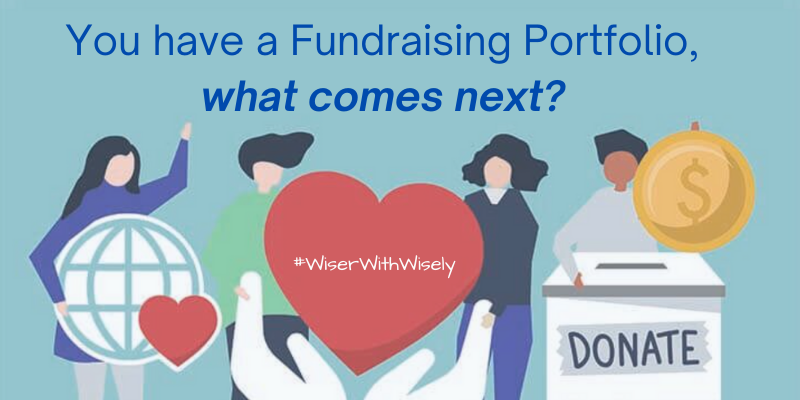
Over the past few weeks on #WiserWithWisely we’ve shared a series of posts on building and managing your fundraising portfolio and how nonprofit fundraising software like Wisely can help your nonprofit grow its fundraising. Now that you understand fundraising portfolio management, it’s time to start using your fundraising portfolio to raise more revenue by building meaningful relationships with your donors and prospects.
In the upcoming posts on #WiserWithWisely, we will talk about donor relationships, cultivation, and stewardship. We’ll be going over everything you need to know about building long-lasting donor relationships that lead to more donations. We will also give you a sneak peek into Wisely’s powerful Moves Management System of sorting and effectively tracking your donor engagement and portfolios.
Why You Need Meaningful Donor Relationships
Just having a fundraising portfolio isn’t enough to keep growing your nonprofit’s revenue year after year, you need to be actively building relationships with your donors and prospects. Donors make gifts to nonprofit organizations because they feel connected to that nonprofit’s mission and to the nonprofit itself. Ultimately fundraising, especially at the major gift level, is about relationships.
Imagine you’re at a coffee shop and a stranger comes over to sit next to you, they start telling you about an issue the community is facing and their plan to fix it. Then they ask you to help by giving them money. How likely are you to give this person money?
Now imagine instead of a stranger, it’s a friend who is asking you for the money. You’re more likely to give them the donation because you know them and you trust that they’re telling the truth and they will use your donation for a good cause. If you look at it this way, it makes perfect sense why relationships are so important for fundraising.
In order for your donors and prospects to see your nonprofit as trustworthy and a good cause to support you need to build a relationship with them, you can’t be a stranger in a coffee shop asking for money! This is where your fundraising portfolio can support your moves management strategy to cultivate and steward donors and prospects to build long-lasting and meaningful relationships.
What is Cultivation?
Cultivation is the second step in donor relationship building, after finding a qualified prospect. During cultivation, you are building a relationship with a donor or prospect from your fundraising portfolio while you work your way up to making a fundraising ask or presenting a proposal.
Fundraising teams can get so wrapped up in making the ask and bringing in a big gift that they may overlook cultivation. But this is the most important step in fundraising moves management for major donors. Good donor cultivation is essential for building long-lasting donor relationships and strengthening your fundraising program.
Make sure your fundraising team isn’t overlooking the importance of cultivation and building strong donor relationships by using moves management strategy based on fundraising best practices with your fundraising portfolio.
Wisely nonprofit fundraising software can help. Not only will Wisely ensure your fundraising team is connecting with donors at each stage of the donor lifecycle, including cultivation, the tools that Wisely offers save your fundraising team time so they can focus on building long-lasting donor relationships.
The Role of Good Stewardship
Stewardship is the process of thanking your donors for their generous support of your cause. However, it takes more than a simple “thanks” to be a good steward of a donor’s gift, you have to show them the outcome of their donation.
Here are a few ways that you can steward your donors, focusing on demonstrating the impact of their donation as well as saying thanks.
- Thank you call following their donation that emphasizes what their gift will make possible.
- Personalized reports for major donors containing updates on the projects that they have funded.
- Regular updates on outcomes from your nonprofit’s work that the donor has helped make possible.
Stewardship is not just a one-and-done task, it’s an ongoing process and it’s just as important to building meaningful donor relationships as cultivation. It’s also as critical to raising more revenue as solicitation.
Good stewardship is important for building trust with your donors. When a donor sees that their gift has been put towards a good cause not only do they feel great about making that donation – they’ll want to give again!
Strategic Moves Management
The donor life cycle is nonstop! Make sure your fundraising team stays on top of every step from cultivating a relationship, making an ask, stewarding donors, and then repeating it all over again to bring in the next gift. Nonprofit fundraising software that manages your fundraising portfolio can help your team keep up with the donor lifecycle.
With cultivation, stewardship, and all the steps in between there are a lot of things to keep track of to build strong relationships with your donors. That’s where Wisely nonprofit fundraising software can help you effectively manage your fundraising portfolio with strategic moves management.
Wisely’s moves management system effectively takes your donors through the donor lifecycle and helps your fundraisers hit every step along the way. Wisely makes it easier for your fundraising team to spend more time doing what matters, building meaningful donor relationships that lead to greater revenue for your nonprofit.
Next week on #WiserWithWisely we’ll dive deeper into cultivation tactics and discuss how your fundraising team can introduce themselves to donors and prospects to begin cultivating a meaningful relationship. Stay tuned!